#React Application
Explore tagged Tumblr posts
Text
Purecode reviews | React components, the building blocks of any React application
React components, the building blocks of any React application, are JavaScript functions that return JSX, a syntax extension for JavaScript, resembling HTML. These components can be organized into reusable blocks of code, making it possible to use the same code or assets across different parts of an application and adjust as needed. JSX, on the other hand, allows for the inclusion of expressions and functions, enabling dynamic content.
#purecode software reviews#purecode#purecode ai reviews#purecode ai company reviews#purecode company#purecode reviews#React Component#React Application
0 notes
Text
React Training in Chennai: Unlock the Power of Modern Web Development with the React JavaScript Library
Introduction
Welcome to our comprehensive guide on React training in Chennai, where we explore the world of modern web development with the React JavaScript library. In this article, we will dive into the significance of React in building dynamic user interfaces, the benefits of React training, and how our training program can equip you with the skills and expertise to excel in React development. If you're passionate about creating interactive and high-performance web applications, read on!
The Power of React in Web Development
React is a popular JavaScript library developed by Facebook. It is widely adopted for building user interfaces, particularly for single-page applications and complex UI components. React utilises a component-based architecture, allowing developers to build reusable and modular UI elements. With its efficient rendering and virtual DOM, React enables developers to create highly responsive and interactive web applications.
Why React Training?
React offers numerous advantages that make it a valuable skill for web developers. By undergoing React training, you can unlock a world of opportunities and gain a competitive edge in the industry. Here are some key reasons why React training is crucial for your web development career:
1. High Demand in the Job Market
React has gained immense popularity in the web development community. Many companies are actively seeking professionals skilled in React to build modern and efficient web applications. By acquiring React skills, you position yourself for lucrative job opportunities and career growth. Whether you're a beginner entering the field or an experienced developer looking to expand your skillset, React training can open doors to exciting roles in top organisations.
2. Efficient and Scalable Development
React's component-based architecture promotes code reusability, modularity, and maintainability. By breaking down the UI into reusable components, developers can efficiently manage complex applications and update specific parts without affecting the entire application. React's virtual DOM also ensures efficient rendering, minimising the need for frequent server requests and improving overall performance. With React training, you'll learn to build scalable and high-performance web applications.
3. Rich Ecosystem and Community Support
React boasts a thriving ecosystem and a supportive community of developers. The React ecosystem offers a wide range of libraries, tools, and extensions that enhance development productivity and simplify common tasks. The active community provides ample learning resources, tutorials, and forums where you can seek guidance, share knowledge, and stay updated with the latest trends and best practices. By joining the React community, you'll have access to valuable resources and networking opportunities.
4. Seamless Integration and Interoperability
React is known for its ease of integration with other libraries and frameworks. It can be seamlessly combined with technologies such as Redux for state management, React Router for navigation, and Axios for data fetching. React's flexibility and interoperability enable developers to leverage the best tools and libraries for their specific project needs. By mastering React, you'll have the skills to build robust and feature-rich web applications by harnessing the power of these complementary technologies.
The Benefits of Our React Training Program in Chennai
When it comes to React training in Chennai, we are committed to providing a comprehensive and practical learning experience. Here's why our training program stands out:
1. Experienced and Knowledgeable Trainers
Our trainers are industry professionals with extensive experience in React development. They bring real-world insights and practical knowledge to the classroom, ensuring that you receive top-notch education and guidance. You'll learn from experts who have successfully implemented React in various web projects.
2. Hands-on Learning Approach
Our React training program fees in chennai follows a hands-on learning approach, allowing you to apply the concepts and techniques in real-world scenarios. You'll work on practical projects, develop interactive web applications, and solve real-time challenges under the guidance of our trainers. This hands-on experience will enhance your skills and build confidence in building React applications.
3. Structured Curriculum and Continuous Support
Our training program covers the fundamental concepts of React, including component-based development, state management, routing, and data fetching. The curriculum is designed to provide a structured learning path, gradually building your proficiency in React. Additionally, we offer continuous support throughout the training program, with regular feedback sessions and assistance to ensure your progress and understanding.
4. Placement Assistance
We understand the importance of career growth and job placement. Our placement assistance program helps connect you with top companies and job opportunities in Chennai. We provide guidance on resume building, interview preparation, and job search strategies to maximise your chances of landing a rewarding job in React development.
Conclusion
In conclusion, Best React training in Chennai is the key to unlocking your potential as a modern web developer. By mastering React, you'll be equipped to build efficient, scalable, and interactive web applications that meet the demands of today's users.
ServicesNow Training in Chennai
Alteryx training in chennai
AWS Training in Chennai
Digital Marketing Course in Chennai
VLSI Training in Chennai
Catia Training in Chennai
Angular JS Training in Chennai
React training in Chennai
AWS Online Job Support From India
AWS Online Job Support From India
#react#react native#react js#react developers#react development#react application#code#nodejs#reactjs#python#programming
0 notes
Text
Unleashing the Potential: Dynamic Data Visualizations with D3.js in React Applications

In the era of data-driven decision-making, the ability to present information in a visually captivating and interactive manner is invaluable. React, the popular JavaScript library for building user interfaces, becomes even more powerful when integrated with D3.js, a versatile data visualization library. By combining React's flexibility and component-based structure with D3.js's rich visualization capabilities, developers can create stunning and dynamic data visualizations that captivate audiences. In this article, we will explore the seamless integration of D3.js with React, unlocking a world of possibilities for creating compelling and engaging data visualizations in your React applications.
1. Understanding D3.js:
D3.js, or Data-Driven Documents, is a comprehensive JavaScript library that provides an extensive toolkit for creating dynamic and interactive data visualizations. Built on web standards like HTML, SVG, and CSS, D3.js empowers developers to transform raw data into meaningful visual representations using a wide range of powerful features and techniques.
2. Integrating D3.js with React:
To leverage the full potential of D3.js in your React applications, follow these key steps for seamless integration:
a. Installing and configuring D3.js:
Begin by installing D3.js as a dependency in your React project using package managers like npm or yarn. Then, import the necessary D3 modules into your React components to make them accessible within your application.
b. Harnessing React's lifecycle methods:
React's lifecycle methods, such as `componentDidMount` and `componentDidUpdate`, play a crucial role in integrating D3.js functionality. These methods allow you to initialize and update D3.js visualizations within your React components at the appropriate times.
c. Harmonizing React's Virtual DOM with D3.js:
React manages the rendering through its Virtual DOM, while D3.js manipulates the actual DOM. To ensure compatibility, use React's `ref` attribute to select and manipulate DOM elements directly using D3.js.
d. Data binding and updates:
D3.js's strength lies in its ability to bind data to visual elements dynamically. Take advantage of D3.js's data-driven approach to bind data to React components, facilitating seamless updates and transitions as the data changes.
3. Unleashing the Synergy of React and D3.js:
By combining React and D3.js, developers can leverage the best of both worlds to create powerful, interactive, and scalable data visualizations:
a. Interactive and responsive visualizations:
React's component-based architecture, combined with D3.js's interactivity and event handling capabilities, enables the creation of highly interactive and responsive visualizations. Users can engage with the visualizations, enhancing their understanding of complex data.
b. Effortless updates and animations:
React's Virtual DOM, coupled with D3.js's transitions, facilitates smooth updates and animations as data changes. This dynamic rendering ensures that visualizations remain up to date and visually pleasing.
c. Customization and reusability:
D3.js offers extensive customization options, enabling developers to create visually stunning and tailored visualizations. By integrating D3.js with React's modular architecture, visualizations can be encapsulated into reusable components, promoting scalability and code reusability.
Benefits of Using D3.js with React
Using D3.js with React offers several significant benefits for developers looking to create dynamic and interactive data visualizations. Let's explore the advantages of integrating D3.js with React:
1. Powerful Data Visualization Capabilities:
D3.js is a highly versatile and comprehensive data visualization library. By combining it with React, developers can leverage D3.js's extensive range of features, such as data binding, scales, transitions, and interactive elements. This combination empowers developers to create visually stunning and meaningful data visualizations that effectively convey complex information.
2. Component-Based Architecture:
React's component-based architecture aligns well with D3.js's modular approach. Developers can encapsulate D3.js visualizations into reusable React components, making it easier to manage and maintain complex visualizations. React's component reusability promotes code efficiency and scalability, enabling developers to create a library of customizable visualization components.
3. Seamless Integration:
React's flexibility and lifecycle methods allow for seamless integration with D3.js. Developers can leverage React's lifecycle methods, such as `componentDidMount` and `componentDidUpdate`, to initialize and update D3.js visualizations at the appropriate times. This integration ensures smooth rendering and data updates, providing a seamless user experience.
4. Virtual DOM and Efficient Rendering:
React's Virtual DOM optimizes rendering performance by updating only the necessary components when the underlying data changes. By integrating D3.js with React, developers can take advantage of this efficient rendering process. React's reconciliation algorithm ensures that only the affected components are re-rendered, resulting in improved performance and responsiveness for data visualizations.
5. Enhanced Interactivity:
React's event handling capabilities combined with D3.js's interactive features enable developers to create engaging and interactive data visualizations. React's state management allows for dynamic updates and interactions with the visualizations, providing a seamless and interactive user experience. Users can interact with the visualizations, explore data, and gain insights in a more intuitive and engaging way.
6. Robust Ecosystem and Community Support:
Both React and D3.js have vibrant communities and extensive ecosystems. By integrating D3.js with React, developers can tap into a wealth of resources, tutorials, and community-driven libraries. This support system provides developers with valuable insights, best practices, and tools to create high-quality data visualizations efficiently.
Conclusion: Integrating D3.js with React empowers developers to create dynamic and visually captivating data visualizations within their applications. By combining React's flexibility, component-based structure, and state management with D3.js's powerful data manipulation and visualization capabilities, developers can convey complex information effectively and engage users through interactive visual experiences. So, dive into the world of data visualization with React and D3.js, and elevate your React applications with stunning and meaningful visual representations of data.
#Integrating D3.js with React#react d3#using d3.js in react#data visualization with React and D3.js#d3.js#react application
0 notes
Text
Advanced Tips and Tricks for Debugging React Applications

React is a popular JavaScript library for building web application user interfaces. While developing with React, developers face various issues that can be solved with strong debugging skills. By effectively troubleshooting and resolving these problems, developers can save time and deliver high-quality React applications.
Common issues during React development include syntax errors, rendering problems, state management challenges, runtime errors, event handling issues, lifecycle method errors, prop type mismatches, dependency conflicts, routing problems, styling and CSS issues, and API integration problems. To resolve these issues, developers should read error messages carefully, use debugging tools, and consult React’s documentation and community resources.
Improving debugging skills allows developers to quickly identify and fix problems, enabling them to overcome challenges efficiently and deliver high-quality React applications.
Debugging in React Application
Debugging is essential for React developers, especially as projects grow more complex. In this blog post, we will explore advanced debugging tips and tricks for React applications. Our aim is to equip you with the knowledge and tools to tackle even the most elusive bugs.
Strong debugging skills are essential for React applications. Techniques like console logging, browser tools, and React Developer Tools can help address issues like unexpected behavior, state management challenges, slow rendering, and complex data flow. Error boundaries and the React Profiler aid in error handling and performance optimization. By effectively applying these debugging skills, developers enhance functionality and boost React application performance.
By refining your debugging skills, you’ll be well-prepared to navigate the complexities of React application development and deliver robust and efficient solutions. So, let’s dive into the world of debugging React applications and uncover the secrets of bug hunting!
1. Use console logging
Console.log in React helps debug code by logging information to the browser’s console. It tracks variables, checks function execution, and inspects values during runtime.
Power of console.log:
Outputting Information: Console.log easily displays messages, variables, objects, and other data types in the console.
Real-Time Insight: Placing console.log strategically reveals real-time insights, tracking execution flow, variable values, and component/function interactions.
Problem Diagnosis: Console.log helps diagnose issues by logging relevant data such as function parameters, intermediate values, or error messages.
Tracking Code Execution: By logging messages at key points like lifecycle methods or event handlers, console.log enables tracking and validation of code execution.
Iterative Development: Console.log aids in iterative development by logging values and verifying code output, facilitating incremental adjustments and validation.
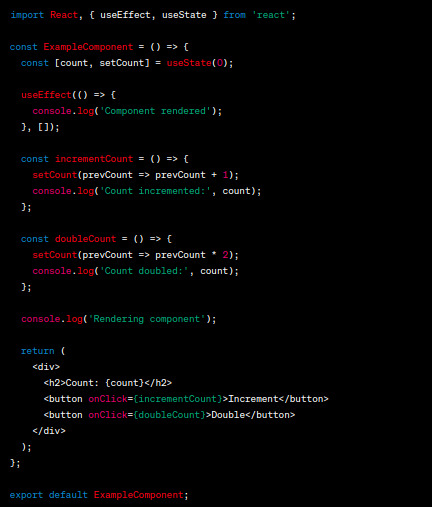
In this example:
The component renders a count value and provides buttons to increment and double the count.
The useEffect hook logs “Component rendered” once when the component is mounted.
The incrementCount function increments the count and logs the current count value.
The doubleCount function doubles the count and logs the current count value.
A console log message “Rendering component” is placed to track the rendering of the component.
By observing the console output, you can see when the component is rendered, track count changes, and monitor component rendering.
2. Use React Developer Tools
React Developer Tools is a browser extension that helps developers debug React applications. It offers a range of features to understand, inspect, and manipulate components and states. Here’s how it aids in debugging large-scale applications:
Component Hierarchy: Provides a tree view of all components, helping understand complex hierarchies.
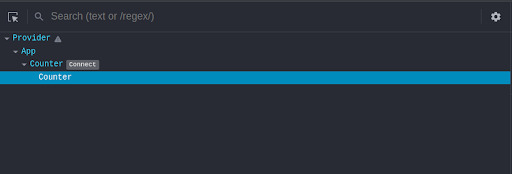
Component Inspection: Allows inspection of individual components, including props and state.
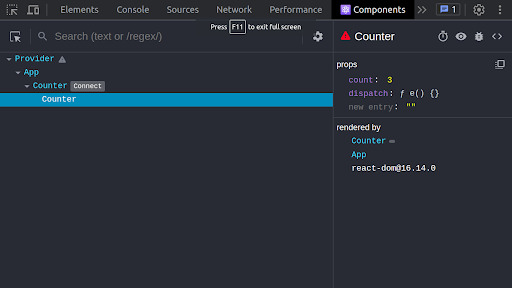
State Management: Integrates with popular libraries like Redux to inspect and track state changes.
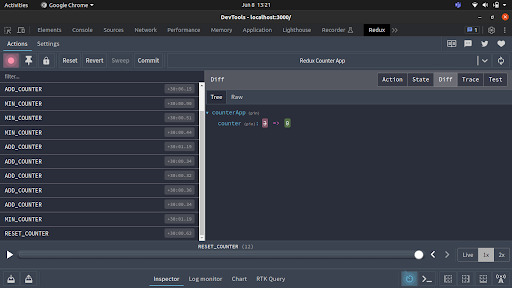
Performance Profiling: Measures render times, identifies re-renders, and detects performance bottlenecks.
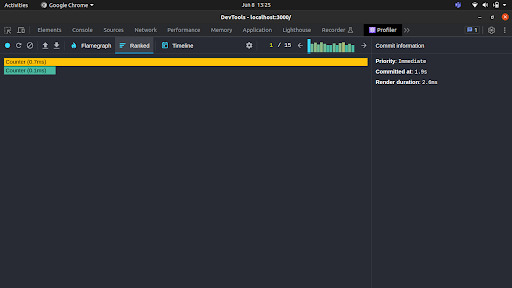
React Developer Tools empowers developers by providing insights into React applications, assisting in understanding hierarchies, inspecting states and props, tracking changes, identifying performance issues, and debugging complex scenarios. These capabilities are valuable for extensive and intricate codebases in large-scale applications.
3. Implementing React Error Boundaries
React Error Boundaries catch JavaScript errors in their child component tree during rendering, lifecycle methods, and event handling.
They prevent the entire application from crashing by handling errors gracefully.
When an error occurs within the subtree of an Error Boundary component, it displays a fallback UI instead of the crashed component tree.
Error Boundaries are similar to “try-catch” blocks in JavaScript but are specific to React components.
They improve user experience by displaying a fallback UI and allowing the rest of the application to function without disruption.
Error Boundaries aid in debugging and error reporting by logging and analyzing errors.
They help isolate errors to specific components, preventing them from impacting the entire application.
4. Utilize strict mode in react application
React Strict Mode is a developer tool that detects and flags potential problems in a React application. It applies strict checks and warnings to identify common mistakes and performance issues, helping developers address them during the development process.
React Strict Mode helps in the following ways:
Identifying Unsafe Practices: Detects and warns about unsafe lifecycle methods, deprecated features, and potential issues in your codebase.
Highlighting Side Effects: Detects unexpected side effects during component rendering, helping you identify and fix unintended consequences.
Catching State Mutation: Warns about state mutations, ensuring a more predictable and maintainable application state.
Detecting Deprecated Features: Alerts about deprecated features, encouraging updating code to utilize recommended alternatives.
Performance Warnings: Provides performance-related warnings, optimizing application rendering performance.
5. Debugging Asynchronous Operations
When debugging asynchronous operations in a React application, there are several important points to consider. Here are some key aspects to look into:
API Calls: Use console.log or debugger before and after making requests. Check the browser’s “Network” panel for details.
State Management: Console.log or debugger where state changes occur. Use browser tools or extensions for deeper inspection.
Promises: Log resolved values and handle errors using console.log or debugger within “then” and “catch” methods.
Async/await: Set breakpoints on “await” lines to inspect variables. Use try-catch blocks for error handling.
Timer-based operations: Place console.log or debugger in timer callbacks to understand timing and code execution.
Combine techniques and tools like console.log, debugger, and browser developer tools for effective debugging.
6. Inspect Component Props and State
To improve your React application’s performance, follow these steps:
Add console.log statements: Place console.log statements in important parts of your code, such as lifecycle methods, event handlers, or useEffect hooks. Log relevant data like props, state, or variable values to track execution flow and observe data changes.
Examine prop flow: Analyze how props are passed down the component tree. Avoid unnecessary drilling of props through intermediate components, as this can cause unnecessary re-renders. Optimize performance by using techniques like React.memo or shouldComponentUpdate to prevent re-rendering when props or states haven’t changed.
Use performance profiling tools: Take advantage of performance profiling tools available in your development environment. Measure CPU usage, memory consumption, and network requests to identify potential bottlenecks. Optimize your code based on the insights gained from profiling, ensuring an efficient and responsive React application.
By implementing these techniques, you can gain valuable insights into component flow, optimize performance, and create an efficient and responsive React application.
7. Debugging Common React Issues
React Developer Common Errors & Solutions:
Syntax Errors: Review and fix typos, missing brackets, or incorrect syntax in your code.
Rendering Issues: Check component rendering logic, lifecycle methods, and props/state usage.
State Management Issues: Review state management approach, initialize/update state properly, and ensure correct state access.
Undefined or Null Errors: Handle cases where variables or properties may be undefined or null.
Event Handling Issues: Double-check event handlers bind ‘this’ correctly, and access event properties properly.
Prop Type Mismatches: Define and enforce prop types to ensure correct data types.
Analyze Network Requests: Use browser network tools to inspect API requests and responses.
Dependency Conflicts: Carefully manage dependencies, ensure compatibility, and resolve conflicts.
API Integration Problems: Review API integration code, check endpoints, format data correctly, and handle responses/errors appropriately.
Remember to analyze error messages, refer to documentation, and seek community resources for solutions. Experience and practice will enhance your ability to identify and resolve these common React errors.
8. Test with different environments and browsers
Testing your React application in different environments and browsers is crucial for debugging and improving your code. It offers several benefits:
Bug Reproduction and Isolation: Testing in various setups helps reproduce and isolate bugs that may be specific to certain environments or browsers. This aids in understanding the root cause and finding solutions.
Browser-Specific Issue Identification: Different browsers have their own quirks and behaviors that can affect your React application. Testing in multiple browsers helps identify browser-specific issues, allowing you to address them appropriately.
Performance Optimization: Testing in different environments and browsers reveals performance bottlenecks that may be specific to certain setups. This enables you to optimize areas of your code and improve overall performance.
Accessibility Testing: Testing with screen readers and accessibility tools in different environments ensures your application meets accessibility standards. It helps identify and address any accessibility-related issues for better usability.
Cross-Platform Compatibility: Testing on different platforms ensures your React application works consistently across devices and operating systems. It helps identify platform-specific bugs or limitations, allowing you to provide a seamless experience for all users.
Conclusion:
Debugging React applications can be challenging, but with the right techniques and tools, developers can effectively identify and resolve issues. In this post, we explored advanced tips for debugging React apps, including console logging, React Developer Tools, Error Boundaries, strict mode, and more. By following these steps, you’ll improve your ability to tackle complex bugs and enhance the quality of your React applications. Remember to be patient and persistent during the trial-and-error process of debugging. Analyze error messages, consult React’s documentation and community resources, and practice regularly to become a proficient debugger. With experience, you’ll gain a deeper understanding of React’s inner workings and build robust applications.
Read More Advanced Tips and Tricks for Debugging React Applications
#React Application Development#React Application#React Component#React Developer#Debugging React Applications
0 notes
Text
i talked about it a little bit already but i have things to say about it. for context, i was born with amniotic band syndrome. the amniotic band wrapped around my left wrist in utero and stunted the growth of my hand. i was born with about half a palm, four nubs for fingers, and a twisted half of a thumb. i can open and close my thumb and pinkie joint like a claw.
yesterday at work i had a shift in the room with 5-10 year old kids. i had my left hand hidden in my sleeve (a bad habit of mine). a kid asked if he could see my hand, and even though internally i was debating running into traffic, i said “sure you can” and showed him my hands. he stared for a moment, looking disturbed, and then said “i don’t want to look at that anymore”. that hurt to hear, but i understand that kids are new to the world and he probably didn’t mean it out of malice. i put my hand away again, told him that it was okay, and that i was just born that way.
he then went on to talk about how he knows a kid with a similar hand to mine and called it “ugly”. i told him that wasn’t a very kind thing to say and that he wouldn’t feel good if someone said that to him, and he replied that no one would say that to him—because he has “normal hands”, and he’s glad he does because otherwise he’d be “ugly”. i tried to talk with him for a bit about how everybody is born differently, but he just started talking about a girl he knows with a “messed up face” and pulled on his face to make it look droopy. i went on some more about how it wasn’t very kind to talk about people that way, but the conversation moved on to something else.
i’ve told my supervisors about it and they��re going to have a talk with his mom. what i wanted to say is this: i’m genuinely not upset with the kid. kids are young and naturally curious, and he clearly simply hasn’t been taught about disabled people and kind ways to speak to/about others. which is why i am upset with his parent(s). i know he’s encountered visibly deformed/disabled people before (he said so himself!), yet his parent(s) clearly haven’t had any kind of discussion with him about proper language and behavior. i knew from birth that some people were just different than others, but my parents still made a point to assert to be kind to and accepting of others. i wonder if adults in his life are the type of people to hush him and usher him away when he points out someone in a wheelchair. that kind of thing doesn’t teach politeness. it tells children that disabled people are an Other than can’t be acknowledged or spoken about; which, to a child, means disability must be something bad.
i’m lucky enough that this was a relatively mild incident, and that i’m a grownup with thicker skin. i’m worried about the other kids he mentioned to me. has he been talking to them this way? when i was a kid, i had other kids scream, cry, and run away at the sight of my hand. or follow me around pointing at me and laughing at me. or tell me i couldn’t do something because i was ugly or incapable or whatever. one time a girl at an arcade climbed to the top of the skeeball machine, pointed at me, and screamed at me to put my hand away and wouldn’t stop crying until she couldn’t see me anymore. another time, a kid saw my hand, screamed at the top of her lungs, and ran into my friend’s arms, crying hysterically about how i was scaring her. that second incident made me cry so hard i threw up when i got home. i can kind of laugh it off now, but having people react to me that way as a child is something i’m still getting over. why do you think i have a habit of keeping my hand in my sleeve? it just irritates me to see children that have clearly not been taught basic manners and kindness—their parents Clearly missed something pretty important .
#and for the record i consider my deformity pretty mild. maybe i’m just used to it but things like amniotic band syndrome can turn out a lot#more severe. i rarely even call myself disabled because i don’t feel like the term is applicable to me. i’m more hindered by like#my adhd anxiety depression etc than i am my hand. so for those kids to react that way to what i THINK#is a pretty small thing. makes me worry about people that are more visibly disabled#Kids.That are more visibly disabled
3K notes
·
View notes
Text



MERYEM UZERLI AS HÜRREM SULTAN
Which is the greater sin? To care too much? Or too little?
#hürrem sultan#hurrem sultan#meryem uzerli#magnificent century#muhteşem yüzyıl#muhtesem yuzyil#mcedit#perioddramaedit#period drama#quote from diary of a poison master#I feel this quote is particularly applicable to how she's expected to feel about suleiman being with other women#bc she's ridiculed and isolated when she's rightfully expressing how upset it makes her#but I imagine he'd be just as pissed off if she completely didn't care#as would everybody else#which is shown through how people react to mahidevran RIGHTFULLY criticising and falling completely out of love with suleiman
81 notes
·
View notes
Text
the hardest part of writing is cutting very good passages simply because they don't fit the narrative in a cohesive way. ok remember this part?
He expected Gao Jianli to appreciate the story in the same way. But the look on the musician's face made him stop short. He had taken off his blindfold, there was no awe in his eyes, only pity. "It must have been very painful," Gao Jianli whispered. "What's a little pain in the grand scheme of things?" the king replied with a laugh, amused by this girlish sentiment. "One suffers for a brief moment and earns a lifetime of benefits from it. Besides, I hardly remember it now." The musician did not answer. He plucked a few notes on the zhu, and they sounded like raindrops falling on a hot terracotta roof. A gentle pitter-patter followed by the hiss of rising steam, like a tiny, sorrowful sigh.
Here's what was suppose to come after it:
The king frowned, not knowing if he liked this strange sound. It made something ache deep within his chest, a totally alien sensation. Like he was a bronze chime being rung with a mallet. Like the feet of one thousand ants marching across his skin. Like a cool, soft hand slipping under his clothes, tracing his fever-hot skin, and slotting itself between the bones of his ribs, worming around the fragile, blood-red membranes of his spleen and liver, so wrong and so, so gentle, higher and higher, until it reached his chest and laid itself softly over a bruise-- "That's enough!" King Ying Zheng's voice rang out harshly in the large, austere room. He had stepped backwards impulsively and almost tripped over the long train of his coat. It was a jerky, undignified movement, like he had been burned. Gao Jianli flinched at the king's voice and silenced the strings with press of his hands. His head was bowed like he was expecting a blow, yet his small, bright eyes were still focused intently on Ying Zheng. The king stood there glaring at the musician, his chest heaving like he had run a mile, his mind all mist and jagged rocks. There was a gnawing at the back of his throat, the ghost of a memory of a boy who had been screaming for a long time, the wound torn afresh by the sight of a door opening twenty-three years too late, which was worse than never opening at all. "Did that not please you, My King?" Gao Jianli's voice was rough. His tongue, small and pink, darted out and licked a bead of sweat from his upper lip. Ying Zheng itched to strike him, but could not force himself to get close enough to do so. The alchemy of Gao Jianli's music had not yet dissipated, the trembling coward was transfigured, in that moment he was half a sage and half venomous snake. With great effort, the King of Qin collected the scattered pieces of himself with an imperious thrust of his chin. Qin men never show fear. In the bare light of day, the king could clearly see that the musician's hands were in fact very calloused. The tips of his fingers were armored in a thick yellow carapace, forged by decades of constant practice. Of course they're rough. The king reminded himself uneasily. Why had he assumed those hands would be soft?
cutting this was the hardest decision in my life, but it just didn't fit. i cranked up the emotion too high without enough build-up, or any way to balance it out on the other end. (to put it frankly, there's not enough foreplay.) also gao jianli is suppose to be passively suicidal right now, and they've only just met. it would be a 180 for his character.
#my writing#gao jianli#ying zheng#if you read my writing without any of the unpublished jing ke x gao jianli stuff (coming soon!) you'd probably assume i'm queerbaiting on#spectrum that only shrimp and supernatural fans can percieve#but this is LITERALLY only applicable to GJL and YZ#i cannot stress this enough. jing ke and gao jianli act like a totally normal couple.#idk why ying zheng and gao jianli are reacting like two rare earth magnets who have been duct taped togather same pole to same pole.#but they DO
18 notes
·
View notes
Text
ok americans did kind of go off with the uhc ceo stuff
#good to see people react like this#for once i think the we are the change revolution rah attitude is true and applicable
7 notes
·
View notes
Text
Ohhhhhgghhh non breath oblige lyrics ough 🤤🤤🤤🤤🤤🤤🤤🤤
FUCKKK just reread the lyrics zoid fn f .
I need to kill this wretched pink creature why is he like That

Im Insane Im crazy im Wacky 🙂
Learned helplessness or something or whatevrr the things called. Like babe does your ass hurt from sitting in the corner and being depressed cmon
Graggh just like hes so anxious about his decisions he’ll either not make one or let everyone else make them for him. Which makes his anxiety worse cuz now hes thinking about how he should’ve made a decision and how the current one will affect their lives for the worst,despite which decision was made.
And i guess it also relates to the thingy i talked about before how he like blames himself before even considering the possibility the other person is at fault and just keeps quiet about everything to try keep people happy and less likely to hurt him.
Hes so awesome
#orb pondering#WHY IS HE LIKE THIS BASHING HIS HEAD IN WITH A MILLION ROCKS#this is actually also applicable to e-void its just hes not as consistent with this#like yeah he used to be in those scrnarios all the time but zoid consistently reacts like this without external forces#the internalizerrrrrr#zoid be normal challenge (impossible)#kill him dead#i love this song so much eurgh#makes me shaking and crying rn markiplier style#its so good 🤤🤤🤤#zoid|⚡️|
3 notes
·
View notes
Text
my biggest nitpick with bg3 is that they call dame aylin an aasimar when (as far as i know dnd lore) she's a deva
#it's a VERY petty thing. i do genuinely like the worldbuilding implication that aasimar in this setting/timeframe are like#special rare valued things. people react to her with awe#that's honestly pretty cool. good application of dnd worldbuilding. but also as the kid of a literal god she's a deva#which is a straight-up ANGEL and not just an aasimar and i want playable aasimar dlc so i can do the ultimate rigel run#@ larian. give it to me.#yin-thoughts#baldur's gate 3#baldur's gate 3 spoilers#bg3 spoilers
11 notes
·
View notes
Text
ok im beggin y'all for a few incredible folks to do a summary of whatever the fuck happens at the dinner tomorrow bc i won't be able to watch until at absolute minimum an hour after it starts and by then i imagine if there's going to be a firestorm, it'll already be over, so i need the DEETS i am begging someone to put it all in one place
#qsmp#normally i would like i did w the timer and the code attacks but yknow#gotta make my 12 bucks an hour lmfaooo#shut up vic#block game brainrot#feel free to skip any funnies i'll find those on my own if necessary i just need the Lore (if applicable)#'deets' is an exaggeration i don't need exact details i need a broad summary of anything that seems important#i'll leave important up to individual discretion anything can be 'important'#like i'll backread the tag of course but if something big happens the tag's going to have a lot of people reacting to the same thing#and that'll make it hard to read what happened before that so#idk i'm tired to the point of delirious tbh i should stop talkin k love you have a good week
46 notes
·
View notes
Text
I think that my endless sobbing in the last 3 hours or so aren't normal
#when I whined to a friend about it she used the word trigger a lot when describing my situation back to me#and while it is not trauma resurfing so the word trigger isn't really applicable here#if it is me reacting to a trigger that would explain a lot#i just hope i can finally fall asleep so that i wake up tomorrow and go get the hugs i need to calm me down
8 notes
·
View notes
Text
#mobile app development#mobile application development#app development companies#hire react developers#hire react native developers#reactjs#hubspot dedicated developers#hire developers#web development#web application development#marketing#branding#web design
3 notes
·
View notes
Text


ryo demonstrating how one is supposed to apply moisturizer to keep cheeks plump
#ryo#hirose ryo#nct#nct wish#nctwish#ryopromoter#reacts#content:youtube#hiroseryo#type:still#cheeks#cheekies#poke#squish#pat#moisturizer application strategies#pat pat#patting#tap#tapping#era:wish
3 notes
·
View notes
Note
Hey I’m a transguy and I haven’t come out to my parents yet because I’m worried about how they’ll react. They know I’m a huge fan of you and your work but when they found out you were trans they got kinda weird about it. My older sibling is nonbinary and I’m worried my parents will think I’m copying them because when they came out my parents kind of ignored it and still call them by their deadname and say they’re my big brother and still use he/him for them and I’m scared to come out. I haven’t even told my sibling because I’m worried they’ll think I’m copying them or they won’t believe me and I just don’t know what to do. I haven’t told anybody I just figured it out two weeks ago and I’m telling you first. Sorry to clog up your inbox you don’t have to respond to this or anything I just needed to vent
hey man, i want you to know that you don't ever have to come out if you don't want to or don't feel safe to. i'm very lucky to be publicly out and face as little discrimination as i do especially as a sex worker and people can absolutely be nasty sometimes
if you wanted my advice i think you should sit on this for a little bit longer, maybe make some trans friends online who you can be yourself with. or even friends irl who are cool and won't out you to your family
if you do really want to come out to your family i might recommend coming out to your sibling first just because it sounds like they have a way better chance of being accepting than your parents do
and my absolute biggest piece of advice. queer to queer. never care what other people think about you. some people are going to hate you for being trans. some people might think you're copying or hopping on a trend. let me be the first to tell you those people don't matter. what you know and care about and how you feel about yourself are the ONLY things that matter. fuck anyone who treats you differently
#some of this might not be applicable to you i dont know your full situation#and i do sincerely hope it works out for you with your family#i think if you want to share this with your sibling it might be a good chance to become closer to them#and it obviously could go wrong#and this is definitely hard to internalize when youre younger and you live with your parents‚ and it might have to be something that waits#until you move out:#but learning how to disregard other peoples opinions of you#especially ones like ''they think i'm copying someone by being myself''#is truly one of the most freeing things you can do for yourself#but anyways lol not to ramble#my big piece of advice on the situation is that if you're worried about how your parents will react is that it's never a bad thing to keep#something like this to yourself#you don't have to tell anyone anything you don't want to#mlb irl
5 notes
·
View notes